
Gwynedd is a county in Wales, sharing borders with Powys, Conwy, Denbighshire, Anglesey over the Menai Strait, and Ceredigion over the River Dyfi. The scenic Llŷn Peninsula and most of Snowdonia National Park are in Gwynedd. Bangor is the home of Bangor University. In the northern part of the county, the other main settlements are Caernarfon, Bethesda, Ffestiniog, Porthmadog and Pwllheli. The largest settlement in the south is Tywyn.

Portmeirion is a tourist village in Gwynedd, North Wales. It was designed and built by Sir Clough Williams-Ellis between 1925 and 1975 in the style of an Italian village, and is now owned by a charitable trust.

Betws-y-coed(listen); English: Prayer House in the Wood) is a village and community in the Conwy valley in Conwy County Borough, Wales, located in the historic county of Caernarfonshire, right on the boundary with Denbighshire, in the Gwydir Forest.

Capel Curig is a village and community in the historic county of Caernarfonshire, currently administered as part of the unitary authority of Conwy County Borough, in Wales. It lies in the heart of Snowdonia, on the River Llugwy, and has a population of 226, reducing slightly to 206 at the 2011 census. It lies at the junction of the A5 road from Bangor and Bethesda to Betws-y-Coed with the A4086 road from Caernarfon, Llanberis, Pen-y-Pass and Pen-y-Gwryd. It is surrounded by hills and mountains, including Moel Siabod and Pen Llithrig y Wrach.

The River Conwy is a river in north Wales. From its source to its discharge in Conwy Bay it is a little over 27 miles (43 km) long. "Conwy" was formerly Anglicised as "Conway."
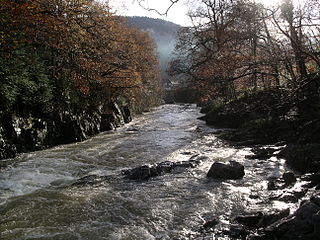
River Llugwy is a tributary of the River Conwy, and has its source at Ffynnon Llugwy, a lake in the Carneddau range of mountains in Snowdonia in north-west Wales.
Susan Williams-Ellis was an English-Welsh pottery designer, who was best known for co-founding Portmeirion Pottery. She was the eldest daughter of Clough Williams-Ellis.

Nant Gwynant is a valley in north Wales. The A498 road descends 600 feet (180 m) into the valley in about two miles from Pen-y-Gwryd; it follows the Nant Cynnyd, the Afon Glaslyn and alongside Llyn Gwynant, then beside the Nant Gwynant river to Llyn Dinas and passing below Dinas Emrys to Beddgelert. The road continues through the Aberglaslyn Pass to Porthmadog.

Plas Brondanw in Carreg Llanfrothen, Gwynedd, North Wales, was the family home of Clough Williams-Ellis, creator of the Italianate village Portmeirion, and elements of similar architectural styles can be seen at both locations. It is a grade II* listed building. The gardens, in a series of garden rooms enclosed by yew hedges and open lawns, linked by carefully planned vistas, is one of only three Grade I listed gardens in Gwynedd.

Dolgarrog is a village and community in Conwy County Borough, in Wales, situated between Llanrwst and Conwy, very close to the Conwy River. The village is well known for its industrial history since the 18th century and the Eigiau dam disaster, which occurred in 1925. The population was 414 at the 2001 Census, increasing to 446 at the 2011 Census. The community extends up to, and includes part of, Llyn Cowlyd in the Carneddau.
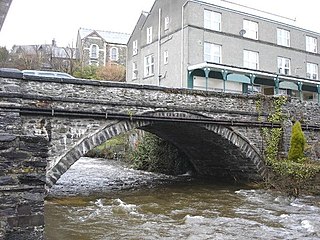
The Afon Crafnant is a tributary of the River Conwy, which is the main river of the Conwy valley in north-west Wales.

The River Geirionydd is a river in Snowdonia, North Wales. It is a tributary of the River Crafnant, which flows over the Fairy Falls waterfall in Trefriw, and thence on into the River Conwy, which is the main river of the Conwy valley.
Afon Ddu is the name of several rivers in Snowdonia in north-west Wales:
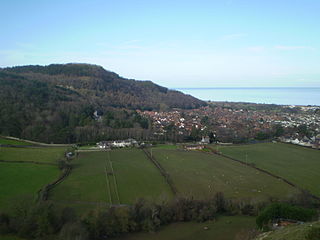
Castell Cawr, or Tan-y-Gopa as it is known locally, is a heavily forested hill above the town of Abergele in Conwy county borough, Wales. On it is found the Iron Age hillfort of Castell Cawr, which overlooks the River Clwyd. Rare lesser horseshoe bats inhabit caves on the hill. The woods are owned by the Woodland Trust. The hill rises to 189 m (620 ft) above sea level, with extensive views to Snowdonia and the Clwydian Range.

Llanfair Talhaiarn, abbreviated to Llanfair TH, is a village and community approximately 5 miles (8.0 km) south of Abergele in Conwy county borough, Wales. Until 1974 it was included in Denbighshire.

The Grey Mare's Tail is a waterfall on the very edge of the Snowdonia National Park near Gwydir Castle in the county of Conwy, north Wales. It lies just off the B5106 road between the town of Llanrwst and the large village of Trefriw. The Welsh name, Rhaeadr y Parc Mawr, derives from the fact that the falls are fed by a large stream that has its source in the Gwydir Forest, and flows through the old Parc Mine, about a mile to the southeast. The name 'Grey Mare's Tail' was given to it by Lady Willoughby of Gwydir Castle, possibly "in compliment to Lord Byron and the Staubbach"

The Afon Dwyfor is a river in Gwynedd, north-west Wales, in total the river is 12 1⁄2 miles (20.1 km) in length. It rises in Cwm Dwyfor at the head of Cwm Pennant, gathers to itself numerous streams which drain the surrounding mountains from Mynydd Graig Goch in the west to Moel Hebog in the east, then flows southwest towards Dolbenmaen and out of the Snowdonia National Park.

The Campaign for the Protection of Rural Wales (CPRW), originally named the Council for the Preservation of Rural Wales, is a charity in Wales that aims to secure the protection and enhancement of the country's landscapes and environment.
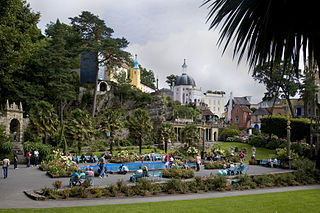
Festival N°6 is an annual art and music festival held in and around Portmeirion, North Wales. The festival presents a wide range of music genres across multiple stages. It is advertised as a family-friendly festival, and as such various areas of the festival are targeted to families, such as "No.6's Mischief Meadow" for children and a designated family camping area. In 2013 one of the organizers stated that due to the size of the village the festival was not likely to grow beyond 10,000 attendees across the weekend.
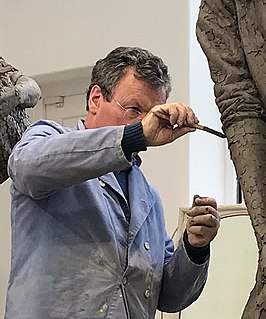
David Williams-Ellis is a British sculptor whose primary subject matter is the human figure.




















